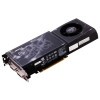- Qualcomm Launches Snapdragon 4 Gen 2 Mobile Platform
- AMD Launches Ryzen PRO 7000 Series Mobile & Desktop Platform
- Intel Launches Sleek Single-Slot Arc Pro A60 Workstation Graphics Card
- NVIDIA Announces Latest Ada Lovelace Additions: GeForce RTX 4060 Ti & RTX 4060
- Maxon Redshift With AMD Radeon GPU Rendering Support Now Available
XFX GeForce GTX 260 Black Edition

No matter your need for graphics power, the choice of GPUs right now is fantastic. Where high-end gamers are concerned, two popular options are the HD 4870 1GB and the GTX 260/216. We’re taking a look at XFX’s latest release of the latter, which features such an impressive factory overclock, it manages to keep up to the GTX 280.
Page 3 – Crysis Warhead
As PC enthusiasts, we tend to be drawn to games that offer spectacular graphics… titles that help reaffirm your belief that shelling out lots of cash for that high-end monitor and PC was well worth it. But it’s rare when a game comes along that is so visually-demanding, it’s unable to run fully maxed out on even the highest-end systems on the market. In the case of the original Crysis, it’s easy to see that’s what Crytek was going for.
Funny enough, even though Crysis was released close to a year ago, the game today still has difficulty running at 2560×1600 with full detail settings – and that’s even with overlooking the use of anti-aliasing! Luckily, Warhead is better optimized and will run smoother on almost any GPU, despite looking just as gorgeous as its predecessor, as you can see in the screenshot below.
The game includes four basic profiles to help you adjust the settings based on how good your system is. These include Entry, Mainstream, Gamer and Enthusiast – the latter of which is for the biggest of systems out there, unless you have a sweet graphics card and are only running 1680×1050. We run our tests at the Gamer setting as it’s very demanding on any current GPU and is a proper baseline of the level of detail that hardcore gamers would demand from the game.



On the introduction page to this review, I mentioned that XFX’s pre-overclocked GTX 260/216 might compete nicely with the GTX 280, but as we can see, there is no “might” about it. In each one of our resolutions here, XFX’s card keeps up to our stock-clocked GTX 280, and in some cases, surpasses it.
|
Graphics Card
|
Best Playable
|
Avg. FPS
|
|
Palit HD 4870 X2 2GB
|
2560×1600, Gamer, 0xAA
|
31.382 FPS
|
|
Palit 9800 GX2 1GB
|
2560×1600, Mainstream, 0xAA
|
50.550 FPS
|
|
Palit GTX 280 1GB
|
2560×1600, Mainstream, 0xAA
|
46.038 FPS
|
|
XFX GTX 260/216 896MB
|
2560×1600, Mainstream, 0xAA
|
45.940 FPS
|
|
ASUS 9800 GTX+ 512MB
|
2560×1600, Mainstream, 0xAA
|
34.319 FPS
|
|
Palit HD 4870 512MB
|
2560×1600, Mainstream, 0xAA
|
32.973 FPS
|
|
ASUS 9800 GTX 512MB
|
2560×1600, Mainstream, 0xAA
|
30.840 FPS
|
|
ASUS HD 4850 512MB
|
2560×1600, Mainstream, 0xAA
|
26.530 FPS
|
|
Gigabyte 9600 GT 512MB
|
1920×1200, Mainstream, 0xAA
|
31.979 FPS
|
Like the GTX 280, “Gamer” isn’t likely to be chosen when using 2560×1600 as your resolution of choice. That particular setting is a lot more playable at 1920×1200, but when maxing out what your 30″ display is made of, you’ll want to scale down to “Mainstream”, which still delivers a gorgeous experience at a comfortable 45FPS.
Support our efforts! With ad revenue at an all-time low for written websites, we're relying more than ever on reader support to help us continue putting so much effort into this type of content. You can support us by becoming a Patron, or by using our Amazon shopping affiliate links listed through our articles. Thanks for your support!






